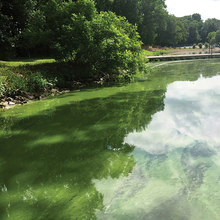It’s harmful algal bloom, and no, it isn’t pretty
If you notice your lake or pond smells swampy and looks like pea soup this summer, it may be from an algal bloom.
Algae are organisms that can photosynthesize in water. Like plants, if they have water, sunlight, nutrients and other factors, they grow.
Those “other factors” are part of what a group brought together by University of Minnesota Extension aims to discover. When all the factors combined get out of balance with cyanobacteria (blue-green algae), there can be “harmful algal bloom.”
“Bloom” might sound pretty enough, but algae bloom isn’t the kind with flowers. It appears differently around the world because algae types differ (the “red tides” in Florida, for example). “The not-so-scientific word we use to describe what we get here in the Midwest is ‘scum,’” says Shahram Missaghi, University of Minnesota Extension water resources educator.
The scum sinks and decomposes, using the water’s oxygen that the fish need. That’s when we hear about “fish kills.”
And it can be toxic. In Minnesota, several dogs have died from swimming in waters with blue-green algal blooms. Humans, farm animals and other pets could also be at risk.
Algae isn’t all bad
“These are the organisms that invented photosynthesis during the dawn of life on earth and oxygenated our environment,” says Anne Wilkinson. She studied under professor Miki Hondzo at the University’s St. Anthony Falls Laboratory and worked with Missaghi as a doctoral student. Now she serves on the Harmful Algal Bloom working group as a water resource engineer with Wenck, a civil and environmental engineering consulting group.
Where and when will blue-green algae appear, and when will they produce bloom?
“It all depends on chemistry, wind, temperature, turbulence, nutrients and complex lake physics, but we still don’t understand exactly when they’re toxic,” says Wilkinson. “By working across organizations, we are learning more.”
“From the state agency side, we are always looking for how to get the word out,” says Pam Anderson, manager of the surface water monitoring section at the Minnesota Pollution Control Agency (MPCA) and member of the working group. “Algal bloom can affect our health, our recreation and our environment.”
What you can do
Approximately 25 percent of Minnesotans depend on water from lakes and streams. We can all play a role in preventing problems that make our water unhealthy.
- Avoid excess lawn and garden fertilizer, which contain nutrients that support algal growth.
- Don’t use phosphorus-containing lawn fertilizer, which is prohibited by Minnesota law in most circumstances. A pound of phosphorus can lead to 500 pounds of algae.
- Leave an un-mowed buffer strip between lawn and lake.
- Never rake leaves or clippings into the water.
- Maintain your septic system properly.
- Eliminate soil erosion and runoff.
If you, your children or your pets come in contact with blue-green algae, wash thoroughly as soon as possible, and keep dogs from licking the algae off their fur.
To report algal bloom, contact the MPCA Water Quality Monitoring Unit (651-757-2822).



